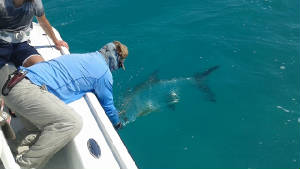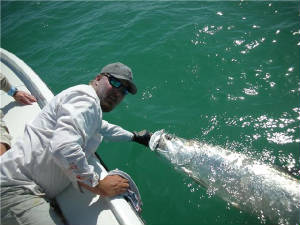|
|
the silver king
The silver king is the most common pseudonym given to the tarpon by anglers, descriptive of the bright flash that reflects from its large silver scales when it jumps into the air. The silver king is the most common pseudonym given to the tarpon by anglers, descriptive of the bright flash that reflects from its large silver scales when it jumps into the air. Tarpon inhabit a large range on both sides of the Atlantic Ocean. The range in the Eastern Atlantic extends from Senegal to the Congo. In the Western Atlantic, the fish primarily inhabit warmer coastal waters concentrating around the Gulf of Mexico, Florida, and the West Indies. However, tarpon are not uncommon as far north as Cape Hatteras, and the extreme range extends from Nova Scotia in the north, Bermuda, and to Argentina to the south. Tarpon have been found at the Pacific terminus of the Panama Canal and around Coiba Island. Tarpon populate a wide variety of habitats, but are primarily found in coastal waters, bays, estuaries, and mangrove-lined lagoons within tropical, subtropical, and temperate climates (45° N-30° S). The normal habitat depth extends to 98 feet (30 m). Although a marine fish, tarpon can tolerate euryhaline environments (0-47 parts per thousand) and often enter river mouths and bays and travel upstream into fresh water. In addition, tarpon can also tolerate oxygen-poor environments due to a modified air bladder that allows them to inhale atmospheric oxygen. The only variable that seems to limit their choice of habitat is temperature, and research shows tarpon to be thermophilic. Rapid decreases in temperature have been known to cause large tarpon kills. During such temperature drops, tarpon usually take refuge in warmer deeper waters. Female tarpon can grow to lengths of over 8.2 feet (2.5m) and reach weights of near 355 pounds (161 kg), with the males generally smaller. Tarpon are slow-growing fish and do not obtain sexual maturity until reaching an age of 6-7 years and a length of about 4 feet (1.2 m). Tarpon weighing about 100 pounds (45.4 kg) typically fall between 13-16 years of age. Male tarpon attain lifespans of over 30 years, while females may live longer than 50 years. A female tarpon held in captivity at the John G. Shedd Aquarium in Chicago, Illinois died in 1998 at the age of 63 The tarpon employs different feeding techniques depending upon its level of growth and development. Stage I larvae
absorb nutrients directly from seawater through the integument. Zooplankton, insects, and small fish compose the diet of stage
II and III tarpon larvae and small juveniles. As tarpon grow, they move away from zooplankton as a chief food source and prey
more exclusively on fishes (especially poecilids and cyprinodontids) and larger invertebrates such as shrimp and crabs. While
juvenile tarpon are planktivorous, adult tarpon are strictly carnivorous and mostly feed on mid-water prey such as mullets,
pinfish, marine catfishes, Atlantic needlefish, sardines, shrimp, and crabs. Tarpon feed during both day and night. Since
the tarpon have minute teeth only, they usually swallow the prey whole
In Florida, the commercial sale of tarpon is prohibited. Recreationally, the tarpon provides a huge industry for charter captains. In the Florida Keys, many of these guides make the bulk of their earnings from April through June, the prime months for tarpon migrations. Recreational anglers must obtain a tarpon tag (purchased prior to catching) in order to possess a tarpon. However, most tarpon guides and anglers esteem the tarpon and nearly always release the fish unharmed. Most mortality attributed to human activity occurs from injuries incurred when being landed, such as "gut hooking" or sharks that take advantage of the hooked fish. Though conscientious anglers attempt to break the line to release the tarpon from restraint, sharks occasionally leave the angler with only half of the fish. Although this is considered an important game fish, the flesh is not highly prized in the United States, though the natives of Panama, the West Indies, and Africa consider the tarpon a delicacy and sell it on a small scale. |


